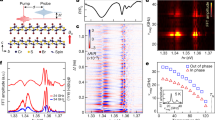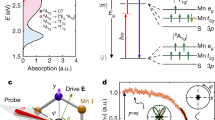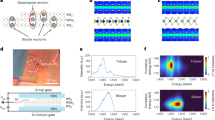Abstract
The interaction between distinct excitations in solids is of both fundamental interest and technological importance. One such interaction is the coupling between an exciton, a Coulomb bound electron–hole pair, and a magnon, a collective spin excitation. The recent emergence of van der Waals magnetic semiconductors1 provides a platform to explore these exciton–magnon interactions and their fundamental properties, such as strong correlation2, as well as their photospintronic and quantum transduction3 applications. Here we demonstrate the precise control of coherent exciton–magnon interactions in the layered magnetic semiconductor CrSBr. We varied the direction of an applied magnetic field relative to the crystal axes, and thus the rotational symmetry of the magnetic system4. Thereby, we tuned not only the exciton coupling to the bright magnon, but also to an optically dark mode via magnon–magnon hybridization. We further modulated the exciton–magnon coupling and the associated magnon dispersion curves through the application of uniaxial strain. At a critical strain, a dispersionless dark magnon band emerged. Our results demonstrate an unprecedented level of control of the opto–mechanical–magnonic coupling, and a step towards the predictable and controllable implementation of hybrid quantum magnonics5,6,7,8,9,10,11.
This is a preview of subscription content, access via your institution
Access options
Access Nature and 54 other Nature Portfolio journals
Get Nature+, our best-value online-access subscription
$29.99 / 30 days
cancel any time
Subscribe to this journal
Receive 12 print issues and online access
$259.00 per year
only $21.58 per issue
Buy this article
- Purchase on Springer Link
- Instant access to full article PDF
Prices may be subject to local taxes which are calculated during checkout




Similar content being viewed by others
Data availability
The datasets generated during and/or analysed during this study are provided with this paper. All other data that support the plots within this paper and other findings of this study are available from the corresponding author upon reasonable request. Source data are provided with this paper.
References
Burch, K. S., Mandrus, D. & Park, J.-G. Magnetism in two-dimensional van der Waals materials. Nature 563, 47–52 (2018).
Belvin, C. A. et al. Exciton-driven antiferromagnetic metal in a correlated van der Waals insulator. Nat. Commun. 12, 4837 (2021).
Bae, Y. J. et al. Exciton-coupled coherent magnons in a 2D semiconductor. Nature 609, 282–286 (2022).
MacNeill, D. et al. Gigahertz frequency antiferromagnetic resonance and strong magnon–magnon coupling in the layered crystal CrCl3. Phys. Rev. Lett. 123, 047204 (2019).
Yuan, H. Y., Cao, Y., Kamra, A., Duine, R. A. & Yan, P. Quantum magnonics: when magnon spintronics meets quantum information science. Preprint at https://arxiv.org/abs/2111.14241 (2022).
Lachance-Quirion, D., Tabuchi, Y., Gloppe, A., Usami, K. & Nakamura, Y. Hybrid quantum systems based on magnonics. Appl. Phys. Express 12, 070101 (2019).
Zhang, X., Zou, C.-L., Jiang, L. & Tang, H. X. Strongly coupled magnons and cavity microwave photons. Phys. Rev. Lett. 113, 156401 (2014).
Chumak, A. V., Vasyuchka, V. I., Serga, A. A. & Hillebrands, B. Magnon spintronics. Nat. Phys. 11, 453–461 (2015).
Li, Y. et al. Hybrid magnonics: physics, circuits, and applications for coherent information processing. J. Appl. Phys. 128, 130902 (2020).
Tabuchi, Y. et al. Coherent coupling between a ferromagnetic magnon and a superconducting qubit. Science 349, 405–408 (2015).
Němec, P., Fiebig, M., Kampfrath, T. & Kimel, A. V. Antiferromagnetic opto-spintronics. Nat. Phys. 14, 229–241 (2018).
Chumak, A. V., Serga, A. A. & Hillebrands, B. Magnon transistor for all-magnon data processing. Nat. Commun. 5, 4700 (2014).
Vogt, K. et al. Realization of a spin-wave multiplexer. Nat. Commun. 5, 3727 (2014).
Au, Y. et al. Resonant microwave-to-spin-wave transducer. Appl. Phys. Lett. 100, 182404 (2012).
Cenker, J. et al. Direct observation of two-dimensional magnons in atomically thin CrI3. Nat. Phys. 17, 20–25 (2021).
Chen, L. et al. Magnetic field effect on topological spin excitations in CrI3. Phys. Rev. X 11, 031047 (2021).
Lyu, B. et al. Probing the ferromagnetism and spin wave gap in VI3 by helicity-resolved Raman spectroscopy. Nano Lett. 20, 6024–6031 (2020).
Zhang, Q. et al. Coherent strong-coupling of terahertz magnons and phonons in a van der Waals antiferromagnetic insulator. 15.
Liu, S. et al. Direct observation of magnon–phonon strong coupling in two-dimensional antiferromagnet at high magnetic fields. Phys. Rev. Lett. 127, 097401 (2021).
Vaclavkova, D. et al. Magnon polarons in the van der Waals antiferromagnet FePS3. Phys. Rev. B 104, 134437 (2021).
Zhang, X.-X. et al. Gate-tunable spin waves in antiferromagnetic atomic bilayers. Nat. Mater. 19, 838–842 (2020).
Mai, T. T. et al. Magnon–phonon hybridization in 2D antiferromagnet MnPSe3. Sci. Adv. 7, eabj3106 (2021).
Sadovnikov, A. V. et al. Magnon straintronics: reconfigurable spin-wave routing in strain-controlled bilateral magnetic stripes. Phys. Rev. Lett. 120, 257203 (2018).
Sun, J., Shi, S. & Wang, J. Strain modulation of magnonic frequency comb by magnon–skyrmion interaction in ferromagnetic materials. Adv. Eng. Mater 24, 21012 (2022).
Telford, E. J. et al. Layered antiferromagnetism induces large negative magnetoresistance in the van der Waals semiconductor CrSBr. Adv. Mater. 32, 2003240 (2020).
Telford, E. J. & et al. Coupling between magnetic order and charge transport in a two-dimensional magnetic semiconductor. Nat. Mater. https://doi.org/10.1038/s41563-022-01245-xx (2022).
Wilson, N. P. et al. Interlayer electronic coupling on demand in a 2D magnetic semiconductor. Nat. Mater. 20, 1657–1662 (2021).
Cenker, J. et al. Reversible strain-induced magnetic phase transition in a van der Waals magnet. Nat. Nanotechnol. 17, 256–261 (2022).
Lujan, D. et al. Magnons and magnetic fluctuations in atomically thin MnBi2Te4. Nat. Commun. 13, 2527 (2022).
Crescini, N. et al. Magnon-driven dynamics of a hybrid system excited with ultrafast optical pulses. Commun. Phys. 3, 164 (2020).
Zhang, X. et al. Magnon dark modes and gradient memory. Nat. Commun. 6, 8914 (2015).
Fung, T. C., Karenowska, A. D. & Gregg, J. F. Broadband phonon to magnon conversion in yttrium iron garnet. Mater. Quantum Technol. 1, 011003 (2021).
Hicks, C. W., Barber, M. E., Edkins, S. D., Brodsky, D. O. & Mackenzie, A. P. Piezoelectric-based apparatus for strain tuning. Rev. Sci. Instrum. 85, 065003 (2014).
Hicks, C. W. et al. Strong increase of Tc of Sr2RuO4 under both tensile and compressive strain. Science 344, 283–285 (2014).
Lee, K. et al. Magnetic order and symmetry in the 2D semiconductor CrSBr. Nano Lett. 21, 3511–3517 (2021).
Acknowledgements
This work was mainly supported by the Department of Energy, Basic Energy Sciences, Materials Sciences and Engineering Division (DE-SC0012509). Sample fabrication and optical measurements are partially supported by AFOSR FA9550-19-1-0390 and FA9550-21-1-0460. Synthesis of the CrSBr crystals is supported as part of Programmable Quantum Materials, an Energy Frontier Research Center funded by the US Department of Energy (DOE), Office of Science, Basic Energy Sciences (BES), under award DE-SC0019443. D.G.C. was supported by the NSF MRSEC on Precision-Assembled Quantum Materials (DMR-2011738). This research was supported by an appointment to the Intelligence Community Postdoctoral Research Fellowship Program at the University of Washington, administered by the Oak Ridge Institute for Science and Education through an interagency agreement between the US Department of Energy and the Office of the Director of National Intelligence.
Author information
Authors and Affiliations
Contributions
X.X. and D.X. conceived the project. G.M.D. performed the measurements with help from J.C., J.F. and Y.J.B. J.C. designed the strain technique and fabricated the samples. G.M.D., J.C., Y.R., X.Z., T.C., D.X. and X.X. analysed the data and interpreted the results. Y.R., T.C. and D.X. built the model and performed the simulations. D.G.C. and X.R. grew the CrSBr crystals. G.M.D., J.C., Y.R., D.X. and X.X. wrote the manuscript with input from all the authors. All the authors discussed the results.
Corresponding authors
Ethics declarations
Competing interests
The authors declare no competing interests.
Peer review
Peer review information
Nature Nanotechnology thanks the anonymous reviewers for their contribution to the peer review of this work.
Additional information
Publisher’s note Springer Nature remains neutral with regard to jurisdictional claims in published maps and institutional affiliations.
Extended data
Extended Data Fig. 1 Comparison of measurements.
Magnetic field dependent magnon spectra obtained by Fourier transformation of a, transient reflectivity and b, TR-MOKE data.
Extended Data Fig. 2 Raw transient reflectivity data at θab = 0°.
a, Magnetic field dependence of the transient reflectivity signal. b, Slice from the raw data taken from a at µoH = 0.3 T. c, The same data in (b) after subtraction of the electronic decay signal.
Extended Data Fig. 3 Raw transient reflectivity data with θab = 2°.
a, Magnetic field dependence of the transient reflectivity signal. b, Fourier transform of (a). c, Slice taken from a along µoH = 0.53 T, that is at the center of the avoided crossing.
Extended Data Fig. 4 Raw transient reflectivity data with respect to θab.
a, Intensity plot of transient reflectivity signal as a function of magnetic field and pump-probe delay at θab = 3°. b, and c, are the same as (a) but with θab = 6° and 9°, respectively. d-f, Time resolved line traces at three selected magnetic field strengths for each θab value.
Extended Data Fig. 5 Angular dependence of magnon coupling.
a-c, Magnon spectra measured at fixed µoH while varying θab. Note that limitations of the experimental apparatus put upper bounds on the accessible field angles. d-f, Simulations of the magnon spectra at fixed µoH while varying θab over the full range of angles. Here the dashed lines show the magnon center frequency and the colored dots show the amplitude.
Extended Data Fig. 6 Raw transient reflectivity data at high strains.
a, Magnetic field dependence of the transient reflectivity signal at a strain larger than the stain induced AFM to FM transition. There is a shift in the data with field, but the lack of any oscillatory signal implies that the crystal is in the FM state at all fields. b, Fourier transform of (a). c, Slice taken from (a) at µoH = 0 T.
Extended Data Fig. 7 Calibration of the strain device.
a, Strain calibration curves for increasing (blue) and decreasing (orange) piezo voltages. Inset shows a picture of the CrSBr flake measured in this study with gold evaporated on top. b, Shift of the P3 Raman peakz with increasing piezo voltage. c, The same peak shown in (b) at 0% (blue) and 1.9% (black) strain.
Supplementary information
Supplementary Information
Additional information on data processing, strain calibration and the theoretical framework.
Source data
Source Data Fig. 1
Raw transient reflectivity data for Fig. 1.
Source Data Fig. 2
Raw transient reflectivity data for Fig. 2.
Source Data Fig. 3
Raw transient reflectivity data and fitting results for Fig. 3.
Source Data Fig. 4
Raw transient reflectivity data and fitting results for Fig. 4.
Rights and permissions
Springer Nature or its licensor (e.g. a society or other partner) holds exclusive rights to this article under a publishing agreement with the author(s) or other rightsholder(s); author self-archiving of the accepted manuscript version of this article is solely governed by the terms of such publishing agreement and applicable law.
About this article
Cite this article
Diederich, G.M., Cenker, J., Ren, Y. et al. Tunable interaction between excitons and hybridized magnons in a layered semiconductor. Nat. Nanotechnol. 18, 23–28 (2023). https://doi.org/10.1038/s41565-022-01259-1
Received:
Accepted:
Published:
Issue Date:
DOI: https://doi.org/10.1038/s41565-022-01259-1
This article is cited by
-
Reconfigurable spin current transmission and magnon–magnon coupling in hybrid ferrimagnetic insulators
Nature Communications (2024)
-
Local control of superconductivity in a NbSe2/CrSBr van der Waals heterostructure
Nature Communications (2023)
-
Magneto-optics in a van der Waals magnet tuned by self-hybridized polaritons
Nature (2023)
-
Magnetically-dressed CrSBr exciton-polaritons in ultrastrong coupling regime
Nature Communications (2023)



